Cracking the Tubulin Code
Antonina Roll-Mecak examines how tubulin diversity might affect cell shape, movement, and recovery after injury.

Inside every cell in the human body, dynamic polymer structures called microtubules rapidly self-assemble and disassemble in response to cellular signals. Critical to maintaining the physical structure of the cell, microtubules sustain a ‘highway’ system that enzymes travel along to ferry cargo within cells.
To understand how life works at such a basic level, people must learn the biophysical properties of microtubules that enable them to respond to cellular cues in real time.
“This is such a fundamental problem that it impacts every aspect of human health and disease,” says Antonina Roll-Mecak, Ph.D., a Principal Investigator in the IRP. “Many disorders have something to do with microtubule dysfunction, including cancer, neurodegeneration, and infectious diseases.
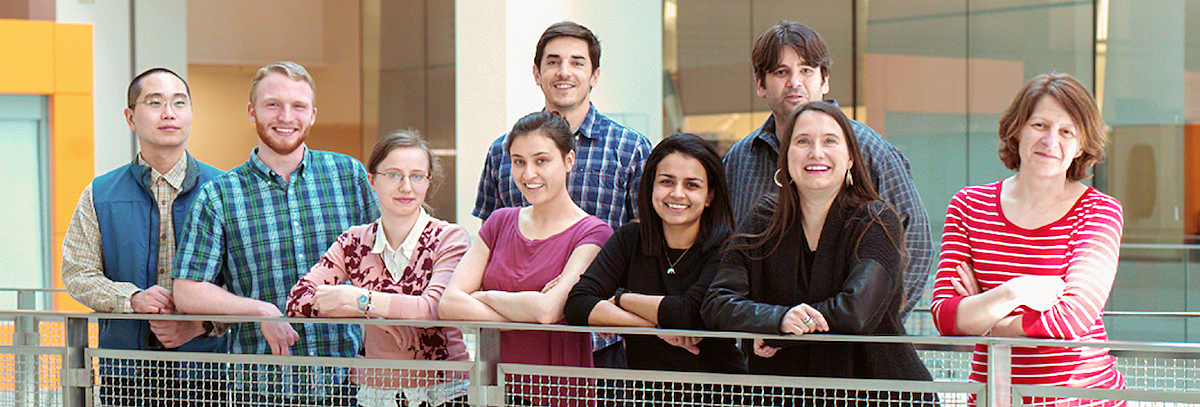
The team (l-r): James Park, Keith Keenan, Ewa Szczesna, Sarah Debs, Christopher Garnham, Annapurna Vemu, Jeff Spector, Antonina Roll-Mecak, and Agnieszka Szyk
At 25 nanometers in diameter, microtubules are composed of smaller subunits of tubulin that function as modular building-blocks, providing a cytoskeleton strong enough to survive the demands of frequent shapeshifting and transport activities. Proteins, including many enzymes, bind to microtubules to influence their behaviors within the cell.
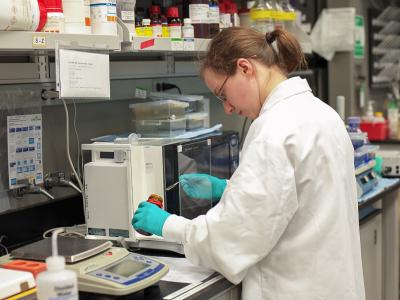
Postdoctoral Fellow Ewa Szczesna, prepares reagents for her experiment.
In biology textbooks, historically, microtubules have appeared as smooth, uniform structures serving the functions of a cellular transport system. However, under the gaze of the advanced imaging and analysis equipment in Roll-Mecak’s lab, microtubules are shown to be much more interesting and diverse.
“The reality is that tubulin is very heavily chemically modified, and those modifications can impact how the microtubule interacts with the other factors in the cell,” Roll-Mecak explains. “My lab is on the forefront of characterizing these modifying enzymes, as well as establishing a biochemical platform to decipher the tubulin code.”
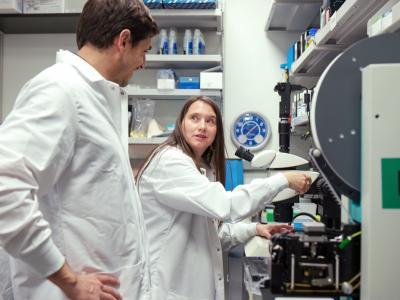
Postdoctoral Fellow Christopher Garnham and Dr. Roll-Mecak discuss crystals of a tubulin glutamylase, TTLL7, viewed under the microscope.
The ‘tubulin code’ is a biological puzzle to understand how the post-translational modifications of tubulin, along with its multiple isoforms, influence microtubule structure and dynamics. However, cracking the tubulin code has eluded scientists for decades.
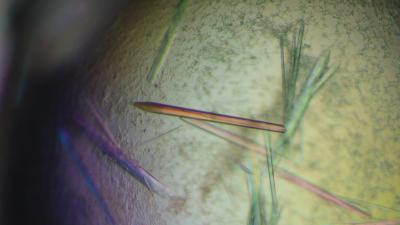
Crystals of TTLL7, an enzyme that adds the amino acid glutamate to tubulin and functions as a "traffic signal" on the cell's "microtubule roadways"
“Tubulin has resisted efforts to be recombinantly produced for the last 30 years,” Roll-Mecak says. “Moreover, there was no in vitro system to produce only a particular ‘flavor’ of a tubulin that, for example, carries just one type of chemical modification. The problem is that the tubulin traditionally used in 99% of labs is highly heterogeneous, with all types of isoforms and modifications that have been scrambled in the purification process. Scientists have been working from a jumbled code.”
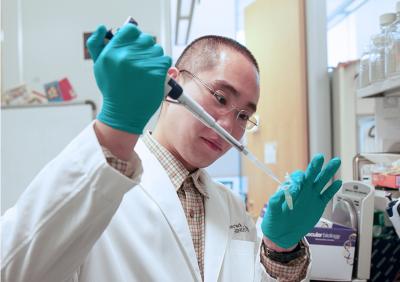
Clinical Fellow James Park prepares DNA for experiments in neurons.
Different types of post-translational modifications occur on microtubules in specific parts of the cell. Therefore, producing un-scrambled tubulin is a very important technical hurdle—one that Roll-Mecak’s lab has been able to overcome.

Staff Scientist Jeff Spector sets-up a single-molecule fluorescence experiment to view individual motors moving on microtubules.
Her team at the NIH IRP has developed a novel biochemical platform that can produce recombinant tubulin of a single type and modify it as desired, which they use to systematically interrogate the effects of each modification on the structure and dynamic behavior of microtubules, as well as the actions of the myriad cellular factors that come into contact with microtubules. By modifying tubulin and observing its behavior, Roll-Mecak’s lab is beginning to understand the broad effects that tubulin post-translational regulation has on basic cellular processes in the body.

Graduate Student Annapurna Vemu and Dr. Roll-Mecak discuss plans for analyzing the dynamics of neuronal microtubules.
“Like any type of code or language, we need to understand how it is written, but we also need to understand how it’s read out,” Roll-Mecak says. “In this case, the code is written by these modification enzymes—they are the ‘writers’—so it’s important for us to understand how they act to write the code. At the same time, we need to know how the cell interprets and reads the information.”

Senior Scientist Agnieszka Szyk transfers DNA samples for analysis.
Considering long cells, like neurons, with axons that can stretch more than three feet and must transport countless loads of cellular cargo every day, it makes sense that such a heavily-trafficked system is especially susceptible to various failures and resulting diseases. Roll-Mecak aims to eventually observe in real time how modification enzymes write their chemical codes on the microtubules and thereby orchestrate microtubule interactions with key cellular components as the cell divides, moves, or extends an axon.

While the science conducted in Roll-Mecak’s lab will have wide-ranging implications for the entire field of cell biology and eventually human health and disease therapy, much research remains to interpret how tubulin code writers and readers work together in normal cells and after injury.
“By providing me protected time to focus 100% on research, the IRP allowed me to tackle a high-risk, high-impact problem that requires a long-term view and stability,” Roll-Mecak says. “Because the microtubule is such a fundamental part of the infrastructure of the cell, pretty much anything that we learn about its function impacts a large array of diseases.”
Antonina Roll-Mecak, Ph.D., is a Senior Investigator in the Cell Biology and Biophysics Unit at the National Institute of Neurological Disorders and Stroke (NINDS). She holds a joint appointment in the Biophysics Center at the National Heart, Lung and Blood Institute (NHLBI).
This page was last updated on Wednesday, May 24, 2023